Papers by manoah muchanga
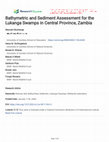
Globally, wetlands are under threats and Lukanga Swamp, a wetland of international signi cance an... more Globally, wetlands are under threats and Lukanga Swamp, a wetland of international signi cance and a Ramsar site, is one of them. The aim of the study was to carry out bathymetric and sediment assessment of the Lukanga Swamp so as to provide further insights into the gravity of sediment load and ascertaining the extent of degradation of the wetlands, and the threats to it. An Hydrographic Survey Boat (HSB) Sonar Model RC-S2 mounted with a Trimble Hemisphere OmniSTAR Virtual Base Station (VBS) for Differential Geographic Positioning System (DGPS) was used to measure water depths across the Swamp. Data on sediment depth was collected using sediment coring method with the aid of a Graduated Sediment Depth Rod (GraSEDD). In sections of the swamp where there were too many weeds, GraSEDD was also used to determine water depth data, instead of the HSB. Photography was also used to collect relevant qualitative data. Quantitative bathymetric and sediment data were analysed using Inverse Distance Weighted (IDW) in ArcMap 10.4 Environment. The swamp water and sediment depths ranged from 0.2m to 4.77m and 0.03m to 2.11m, respectively. The ndings showed that at the time of survey, the water stored in the Swamp was about 2,918 Million Cubic Metres (MCM) and about 1,200 MCM of the Swamp's capacity was lost to sedimentation. The study generally concludes that Lukanga Swamp has signi cantly lost the original storage capacity, a problem, which is recommended to Naturebased Solutions (NbS) so as to preserve the pristine of the natural habitat.
Conservation agriculture (CA) represents a promising solution to the challenges faced by smallhol... more Conservation agriculture (CA) represents a promising solution to the challenges faced by smallholder farmers in Chongwe District. This paper outlines the potential benefits of CA, including increased crop yields, improved food production, reduced input costs, and enhanced nutritional quality and diversity of food crops. Policymakers, agricultural extension services, and development organizations need to prioritize the promotion and adoption of CA practices, providing support for training, capacity building, and access to resources for farmers. The paper also calls for targeted Original Research Article
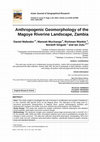
Asian Journal of Geographical Research
Aims: This study sought to investigate the role of humans in modification and creation of landfor... more Aims: This study sought to investigate the role of humans in modification and creation of landforms in river channels with specific focus on the Magoye River. The objectives of this study were to: document geomorphic characteristics of Magoye River, assess anthropogenic activities and landuse/cover change in the buffer zone and, examine key anthropogenic river landforms. Study Design: This study was inspired by analytic eclecticism research philosophy and adopted mixed methods, particularly concurrent research design. Methodology: The landcover images were analysed using image processing tools in ArcGIS 10.4 for the periods 1990, 2005 and 2020. Descriptive statistics were used to quantitatively visualize the changes in land cover/use. The data was collected using field observation, photography, GPS and a Likert scale tool and, analysed using descriptive statistics, specifically frequency graphs showing mean and standard deviation. Results: The results showed that sand mining and bri...
Article , 2024
Conservation agriculture (CA) represents a promising solution to the challenges faced by smallhol... more Conservation agriculture (CA) represents a promising solution to the challenges faced by smallholder farmers in Chongwe District. This paper outlines the potential benefits of CA, including increased crop yields, improved food production, reduced input costs, and enhanced nutritional quality and diversity of food crops. Policymakers, agricultural extension services, and development organizations need to prioritize the promotion and adoption of CA practices, providing support for training, capacity building, and access to resources for farmers. The paper also calls for targeted Original Research Article
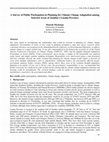
The study aimed at investigating the stakeholders that would be relevant in planning for climate ... more The study aimed at investigating the stakeholders that would be relevant in planning for climate change adaptation. Uncertainties in terms of who could in planning prompted a snap shot survey research whose contextual relevance was premised on the Ahmadabad fourth conference on Environmental Education, to address climate change as a major global issue. It was also contextualized in the frameworks of article six of the United Nations Framework Convention on Climate Change (UNFCCC, 1992) and the Zambia National Adaptation Programme on Action (NAPA). Using a hermeneutic survey design, a sample of 165 households was captured using cluster and simple random sampling techniques. Respondents were interviewed using a semi-structured interview schedule. Overall, the study revealed that planning for climate change would require a diversity of views from multiple stakeholders such as educationists, traditional leaders, the government, affected people, government statutory bodies, clergies, NGOs, among others. Since most of the residents thought adaptation planning to be mainly (35 per cent to 90 per cent), the government's responsibility, it was recommended that further researches be conducted in order to find out how partnership for climate change adaptation planning and learning could be strengthened. The research findings could be useful to environmental educationists and practitioners, researchers, the government and others.
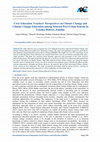
International Journal of Humanities, Social Sciences and Education
Over the years, planet earth has experienced a phenomenon known as climate change, which has brou... more Over the years, planet earth has experienced a phenomenon known as climate change, which has brought about public concern (Chisanga et al., 2022; Huho, 2015). Being a newly emerging social and scientific issue, its place in secondary school curricula has led to Civic Education and other specialized teachers become more equipped with the responsibility of teaching climate change science as well as playing a pivotal role in community awareness about climate change and its consequences (Boon, 2010). Boon (2010) further stated that, the use of the phrase "greening of the curriculum" to describe the process of more environmentally focused content is becoming part of secondary education across all curricula hence, the need to gather some insights on how civic educators understood the phenomenon. Climate change education is a cross-cutting curricular issue, which demands negotiation between discipline-based teachers, timetable and syllabus commitments that constrain opportunities for teaching. The uniqueness of the topic poses a challenge of not many teachers having the confidence in their subject knowledge (Wals, 2010). Many teachers are unprepared for the integration of action and content knowledge that characterizes climate change education, especially those in science where subject knowledge tends to be more facts oriented (Bagoly-Simó, 2022). United Nations Education Scientific and Cultural Organization (UNESCO) (2021) reports that fewer than 40% of teachers are capable of teaching climate change topics such that, only one-third were capable of explaining climate change and climate action concept. According to Niang et al (2014), currently, climate change education has been incorporated into mainstream education globally because of the role of education in society (Monde et al., 2023). Climate change awareness needs to be brought to the attention of learners so as to inculcate knowledge in matters related to climate change such as environmental sustainability. According to UNESCO (2021), countries differ in the aspects of school curriculum where climate change is taught to learners. Among the areas of study where climate change falls include geography, environmental science, social studies, sustainable development, among others. In some countries, school syllabi include climate change as an aspect of human, social and cultural rights. In Zambia, civic education is one of the subjects that tackles climate change (Ministry of Education, 2013).
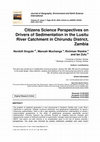
Journal of Geography, Environment and Earth Science International
The problem of sediment generation is very pronounced in Southern Zambia and, Lusitu River Catchm... more The problem of sediment generation is very pronounced in Southern Zambia and, Lusitu River Catchment in particular. Despite numerous positivistic and geophysical explanations on factors influencing sedimentation, there is still a gap regarding comprehensive understanding of citizens science-based perspectives in the study of geophysical processes, specifically around sedimentation. Previous research has primarily focused on mapping land-use changes and assessing the impact of livelihood activities on geomorphic changes using techniques such as GIS, SWAT, and others, but with minimal or no consideration given to the role of citizens scientific perspectives. The study was informed by analytic eclecticism paradigm and used mixed methodology that was inherently citizens science. Data was collected using observation and semi-structured interviews and was analysed using descriptive statistics namely, mean, standard deviation, coefficient of variation and, thematic analysis. The results sh...
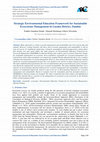
International Journal of Humanities, Social Sciences and Education
Ecosystem services are usually produced along the full spectrum of heavily managed ecosystems (Gu... more Ecosystem services are usually produced along the full spectrum of heavily managed ecosystems (Guery et al., 2015). As a result, a number of approaches to ecosystem management and sustainability have been applied both globally and locally. Some of the notable approaches to ecosystem management and sustainability include the Ecosystem-Based Approach (EBA) (Secretariat of the Convention on Biological Diversity (SCBD), 2004); Ecosystem Approach (EA), and Ecosystem-Based Management (EBM) (Kirkfeldt 2021); Integrated Ecosystem Sustainability Approach (IESA) (Abdullah et al., 2019); global sustainability policies, treaties and conventions (Geijzendorffer, 2017; Monde et al., 2023); and Environmental awareness (Ramachandra, 2008); among others. Despite all these implementation, ecosystems still face threats of degradation. Davis et al. (2020) reveal that Zambia is one of Africa's most resource-rich countries. As such Zambia has put in place various institutional and legal frameworks and developed a number of national policies for ecosystem management and sustainability. Historically, environmental regulations in Zambia date back to the 1970s when the Natural Resource Act was passed for the conservation of nature (Makondo et al., 2015). A year later, this was followed by an Act on game parks and Birds whose objective was to conserve life. Later on, a number of laws including statutory instruments were put in place for the management of the environment. The Environmental Management Act (EMA) number 12 of 2011 is the main act on the environment in Zambia. In its preamble, the act underscores that it shall provide for integrated environmental management, the protection and conservation of the environment, and the sustainable use of natural resources. Table 1 summarizes some legal frameworks in Zambia since 1970.
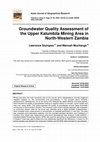
Asian Journal of Geographical Research
Mining has been the main economic stay of the country since independence and has triggered negati... more Mining has been the main economic stay of the country since independence and has triggered negative impacts on the environment and groundwater. It has brought about immerse socioeconomic development, but at the same time released the waste effluents and solid wastes, which threaten the quality of groundwater leading to negative effects on animals, human health and may even cause death. This study assesses the quality of groundwater around Upper Kalumbila mining area in North-western Zambia. This research used a Citizen Science-based mixed methods approach with emphasis on concurrent design. Data for the study was collected using a digital portable multiparameter, which enabled insitu measurement of concentration of selected parameters in real time. The data was analysed using descriptive statistics and this included standard deviation and Coefficient of Variation (CV), which were implemented using Excel Spreadsheet Data Analysis Toolkit (ESDAT). Handheld Global Positioning System (G...
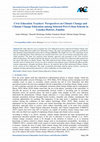
Article, 2023
The study objective was to examine how Civic Education teachers understood Climate Change and Cli... more The study objective was to examine how Civic Education teachers understood Climate Change and Climate Change Education within Civic Education Context. The study used qualitative approach, particularly Discriminative Exponential Descriptive Survey Design (DEDSD). The sample size was 125 comprising closed and one ended questions. Data saturation was reached when there were no new themes emerging from openended questions. The data was analyzed using thematic approach and presented in line with research objectives/questions. The study found that the majority of teachers teaching Civic Education fully understood the causes and effects of climate change. They fully understood that climate change was caused by human activities such as cutting down of trees as well as emission of greenhouse gasses and that the effects include extreme temperatures, droughts and floods. However, the majority did not fully understand Climate Change in the context of Civic Education. The study recommends knowledge sharing among teachers, sourcing of adequate teaching and learning materials as well as embarking on curriculum reform.
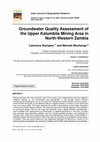
Article, 2023
Mining has been the main economic stay of the country since independence and has triggered negati... more Mining has been the main economic stay of the country since independence and has triggered negative impacts on the environment and groundwater. It has brought about immerse socioeconomic development, but at the same time released the waste effluents and solid wastes, which threaten the quality of groundwater leading to negative effects on animals, human health and may even cause death. This study assesses the quality of groundwater around Upper Kalumbila mining area in Northwestern Zambia. This research used mixed methods approach with emphasis on concurrent design. Data for the study was collected using a digital portable multiparameter, which enabled insitu measurement of concentration of selected parameters in real time. The data was analysed using descriptive statistics and this included standard deviation and Coefficient of Variation (CV), which were implemented using Excel Spreadsheet Data Analysis Toolkit (ESDAT). Handheld Global Positioning System (GPS) was used for geocoding of groundwater access points. A Student T-test was used to determine how statistically significant the difference in means for 30 paired samples was between the measured Turbidity and the WHO ideal standard for groundwater.
Article, 2023
The problem of sediment generation is very pronounced in Southern Zambia and, Lusitu River Catchm... more The problem of sediment generation is very pronounced in Southern Zambia and, Lusitu River Catchment in particular. Despite numerous positivistic and geophysical explanations on factors influencing sedimentation, there is still a gap regarding comprehensive understanding of citizens science-based perspectives in the study of geophysical processes, specifically around sedimentation. Previous research has primarily focused on mapping land-use changes and assessing the impact of livelihood activities on geomorphic changes using techniques such as GIS, SWAT, and others, but with minimal or no consideration given to the role of citizens scientific perspectives. The study was informed by analytic eclecticism paradigm and used mixed Original Research Article
The problem of sediment generation is very pronounced in Southern Zambia and, Lusitu River Catchm... more The problem of sediment generation is very pronounced in Southern Zambia and, Lusitu River Catchment in particular. Despite numerous positivistic and geophysical explanations on factors influencing sedimentation, there is still a gap regarding comprehensive understanding of citizens science-based perspectives in the study of geophysical processes, specifically around sedimentation. Previous research has primarily focused on mapping land-use changes and assessing the impact of livelihood activities on geomorphic changes using techniques such as GIS, SWAT, and others, but with minimal or no consideration given to the role of citizens scientific perspectives. The study was informed by analytic eclecticism paradigm and used mixed Original Research Article
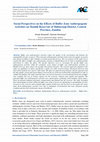
International Journal of Humanities, Social Sciences and Education
Buffer zones are designated areas used to protect hydrologically sensitive landscapes including w... more Buffer zones are designated areas used to protect hydrologically sensitive landscapes including wetlands, wildlife reserves and rivers from external pressures such as those caused and exacerbated by anthropogenic activities (Tagoe and Mantey, 2017). Buffer zones are spaces directly adjacent to water bodies such as lakes, reservoirs, rivers, streams and wetlands. In Zambian context, in accordance with what is provided for in Statutory Instrument No. 1 of 2000, buffer zones are 50m radius from the water boundaries or river banks. These areas have a significant impact on controlling non-point source pollution, sediment generation and bank degradation associated with anthropogenic activities nearby water bodies. Water bodies around the world are known to be the key source of sustainable ecosystems goods and services (Tagoe and Mantey, 2017), however, most water bodies have been and or are being affected by anthropogenic activities along the river and reservoirs banks raising a series of environmental concerns. Most of the environmental impacts associated with catchment degradation are primarily caused by different anthropogenic activities taking place along reservoirs or rivers (Khatri and Tyagi, 2015). Reservoirs are water bodies formed or modified by human activity by

Journal of Natural and Applied Sciences
Small reservoirs in arid and semi-arid areas help rural communities to cope with prolonged dry sp... more Small reservoirs in arid and semi-arid areas help rural communities to cope with prolonged dry spells. More recently, the construction and operation of small reservoirs has resulted in upstream versus downstream water use conflicts in some river basins. In this regard, bathymetric information could be used as a tool to monitor the available surface water, and minimize or prevent water conflicts. The challenge is that it is difficult to survey a large number of reservoirs using the traditional sounding methods. Despite the availability of new methods of conducting bathymetric surveys, their utilization in Africa is still low, particularly for depth measurements of small reservoirs. This paper presents modern bathymetric survey and analysis techniques applied for quantifying the capacities of small reservoirs, using the case of the Kaleya River Basin in southern Zambia. The objectives of the survey were to: i) create a database of reservoir storage capacities; and ii) introduce an eff...
Chapter, 2015
Climate change education (CCE) in Zambia is the subject of this chapter. From a policy perspectiv... more Climate change education (CCE) in Zambia is the subject of this chapter. From a policy perspective, Zambia has in place a National Climate Change Response Strategy as well as the National Adaptation Programme of Action, which address climate change directly. In the formal education arena, climate change aspects are indirectly integrated into the school curriculum, with Geography being the main carrier subject. However, non-formal education activities, driven mainly by associations, clubs and non-governmental organisations, are actively engaged in climate change education, awareness and action.
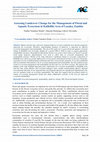
International Journal of Research in Environmental Science
Floral and aquatic ecosystems are important for survival of both human and non-human forms of lif... more Floral and aquatic ecosystems are important for survival of both human and non-human forms of life because of the diverse ecosystem services and goods they provide. [1] Affirm that ecosystems have great contributions to quality of human and non-human life. These contributions derived from ecosystems can be categorised as; provisioning of services such as water, food and timber; regulating services such as climate regulation, erosion control, air quality; supporting services such as soil formation, oxygen production and; cultural services, which include recreational and health benefits [2]. Additionally, ecosystems play an important role in sustainably reducing the risks of disasters [3] such as urban flooding and environmental diseases [4]. As a result, over exploitation of these resources harms the health of the ecosystems and health of the people [5]. [6] also affirms that, despite nature making human life possible, the relentless demand for earth's resources is accelerating extinction rates and devastating the earth's ecosystems. Therefore, protection and management of ecosystems has become an urgent and imperative venture. Ecosystem protection has since the last decade been a popular phrase among various stakeholders such as environmental educators, conservationists and other interdisciplinary communities of scientists [7] and [8]. For example, by the time this study was being conducted, the United Nations launched the United Nations Decade on Ecosystem Restoration 2021-2030 in order to expedite the process of restoring degraded and degrading ecosystem and protect those that were still intact [9]. A study by [10] revealed that all ecosystems irrespective of their geographic location are under some form of stress. However, urban ecosystems are more threatened than those in many rural setups.

Journal of Geography and Geology
This study was conducted within the Zambezi River Basin to ascertain the bathymetry and sedimenta... more This study was conducted within the Zambezi River Basin to ascertain the bathymetry and sedimentation of selected reservoirs, evaluate their seasonal hydrological regimes, pinpoint the causes of reservoir siltation, and determine how the bathymetry and siltation impacted water-related industries and policy choices. Hydrological field measurements using a hydrographic survey boat, document studies, and interviews were used to collect the data. The 3D spatial analyst tools in ArcGIS 10.3 and hypsometric curves were used to analyze bathymetric data. Thematic analysis was used to analyze qualitative interview data. Findings indicated that sedimentation was a problematic phenomenon spatial-temporally and, it triggered a significant decrease in the storage capacities of the reservoirs. The study noted that catchments with small reservoirs were vulnerable to severe water stress, particularly from July through the beginning of the next rainy season in December. Over 90% of the local populat...
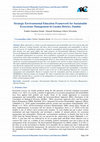
Article, 2023
Many approaches to urban ecosystem management and sustainability have been used locally and globa... more Many approaches to urban ecosystem management and sustainability have been used locally and globally. However, existing literature still shows that ecosystem management and sustainability is still an issue of concern. To complement engineering, ecological, geographical, and legal approaches, among others that already exist and, partly failed, this study proposes an Environmental Education Framework for Ecosystem Management (SEEFREM) in Informal Settings that could be used to promote behavioral change for sustainable management of ecosystems. Seven institutions responsible for ecosystem management were selected from which eight respondents were purposively sampled. Results indicated that there were a number of frameworks designed for ecosystem management. However, these frameworks had not yielded the required results for ecosystem management because they were deemed to be reactive in nature instead of proactive. The study established that legal frameworks were not implemented with succinct behavioral science strategies and, that partly explained the reason for poor ecosystem sustainability. The study established that there was a need for an environmental education framework for ecosystem management and sustainability. A document analysis of institutional frameworks showed a gap in the use of Environmental Education for ecosystem management and sustainability. Based on responses from the respondents and from document analysis, a SEFREEM for informal settings was designed. The study recommends that Policy makers and implementers should take informal EE as a priority in the management of ecosystems as per provisions in the National Policy on Environment of 2007.


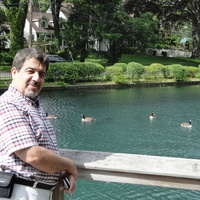







Uploads
Papers by manoah muchanga
concerns facing managers of reservoirs. Yet, its impact
is not widely appreciated. The storage and fate of sediment are some factors to consider to better understand sedimentation in small dams.